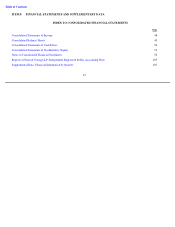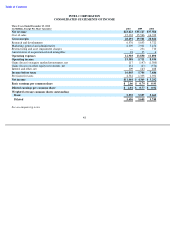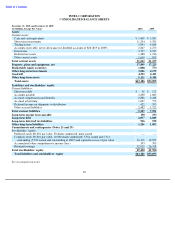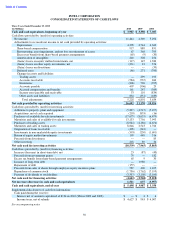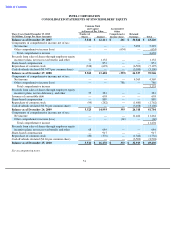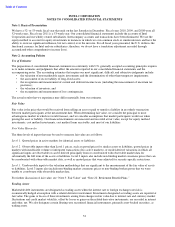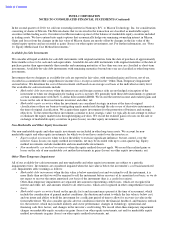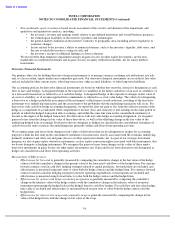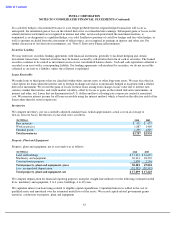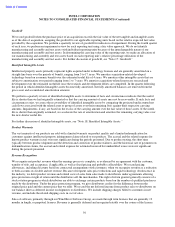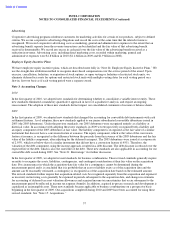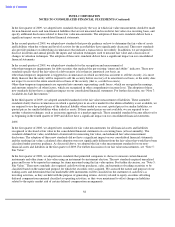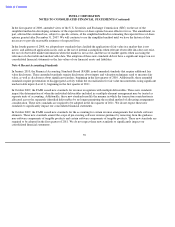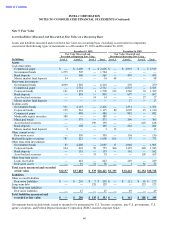Intel 2010 Annual Report Download - page 78
Download and view the complete annual report
Please find page 78 of the 2010 Intel annual report below. You can navigate through the pages in the report by either clicking on the pages listed below, or by using the keyword search tool below to find specific information within the annual report.
Table of Contents
INTEL CORPORATION
NOTES TO CONSOLIDATED FINANCIAL STATEMENTS (Continued)
We record other-than-temporary impairment charges in gains (losses) on other equity investments, net for non-
marketable cost method investments and in gains (losses) on equity method investments, net for equity method
investments.
Derivative Financial Instruments
Our primary objective for holding derivative financial instruments is to manage currency exchange rate and interest rate risk,
and, to a lesser extent, equity market and commodity price risk. Our derivative financial instruments are recorded at fair value
and are included in other current assets, other long-term assets, other accrued liabilities, or other long-term liabilities.
Our accounting policies for derivative financial instruments are based on whether they meet the criteria for designation as cash
flow or fair value hedges. A designated hedge of the exposure to variability in the future cash flows of an asset or a liability, or
of a forecasted transaction, is referred to as a cash flow hedge. A designated hedge of the exposure to changes in fair value of
an asset or a liability, or of an unrecognized firm commitment, is referred to as a fair value hedge. The criteria for designating
a derivative as a hedge include the assessment of the instrument’s effectiveness in risk reduction, matching of the derivative
instrument to its underlying transaction, and the assessment of the probability that the underlying transaction will occur. For
derivatives with cash flow hedge accounting designation, we report the after-tax gain or loss from the effective portion of the
hedge as a component of accumulated other comprehensive income (loss) and reclassify it into earnings in the same period or
periods in which the hedged transaction affects earnings, and within the same line item on the consolidated statements of
income as the impact of the hedged transaction. For derivatives with fair value hedge accounting designation, we recognize
gains or losses from the change in fair value of these derivatives, as well as the offsetting change in the fair value of the
underlying hedged item, in earnings. Derivatives that we designate as hedges are classified in the consolidated statements of
cash flows in the same section as the underlying item, primarily within cash flows from operating activities.
We recognize gains and losses from changes in fair values of derivatives that are not designated as hedges for accounting
purposes within the line item on the consolidated statements of income most closely associated with the economic underlying,
primarily in interest and other, net and gains (losses) on other equity investments, net. As part of our strategic investment
program, we also acquire equity derivative instruments, such as equity conversion rights associated with debt instruments, that
we do not designate as hedging instruments. We recognize the gains or losses from changes in fair values of these equity
derivative instruments in gains (losses) on other equity investments, net. Gains and losses from derivatives not designated as
hedges are classified in cash flows from operating activities.
Measurement of Effectiveness
54
•
Non
-marketable equity investments based on our assessment of the severity and duration of the impairment, and
qualitative and quantitative analysis, including:
•
the investee
’
s revenue and earnings trends relative to pre
-
defined milestones and overall business prospects;
•
the technological feasibility of the investee
’
s products and technologies;
• the general market conditions in the investee’s industry or geographic area, including adverse regulatory or
economic changes;
• factors related to the investee’s ability to remain in business, such as the investee’s liquidity, debt ratios, and
the rate at which the investee is using its cash; and
•
the investee
’
s receipt of additional funding at a lower valuation.
•
Effectiveness for forwards
is generally measured by comparing the cumulative change in the fair value of the hedge
contract with the cumulative change in the present value of the forecasted cash flows of the hedged item. For currency
forward contracts used in cash flow hedging strategies related to capital purchases, forward points are excluded, and
effectiveness is measured using spot rates to value both the hedge contract and the hedged item. For currency forward
contracts used in cash flow hedging strategies related to operating expenditures, forward points are included and
effectiveness is measured using forward rates to value both the hedge contract and the hedged item.
•
Effectiveness for options with hedge accounting designation
is generally measured by comparing the cumulative
change in the intrinsic value of the hedge contract with the cumulative change in the intrinsic value of an option
instrument representing the hedged risks in the hedged item for cash flow hedges. For cash flow and fair value hedges,
time value is excluded and effectiveness is measured based on spot rates to value both the hedge contract and the
hedged item.
•
Effectiveness for interest rate swaps and commodity swaps
is generally measured by comparing the change in fair
value of the hedged item with the change in fair value of the swap.


